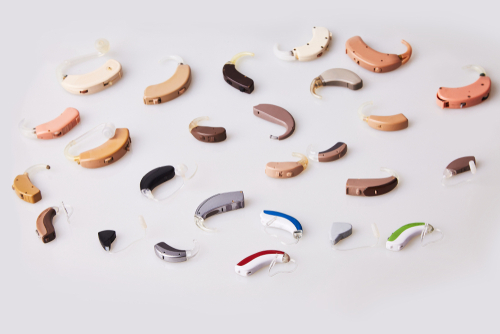Hearing loss is a common condition affecting millions worldwide, impacting their ability to communicate, socialize, and overall quality of life. In other words, you’re not alone if you are concerned about your hearing loss risk or already dealing with hearing issues. At Eldorado Hearing, we help people just like you every day.
Hearing loss can be scary, but with the right information and support, you can continue to enjoy your favorite activities. We offer testing, fitting, and repair in a comfortable environment. In addition, our skilled team can answer your questions about various treatments, preventative measures, and hearing loss in general. It is essential to have a solid understanding of the three basic forms of hearing loss and explore ways to improve hearing health in order to address and manage hearing loss successfully. Continue reading to learn more.

Three Types of Hearing Loss
There are three main hearing loss types, all with unique characteristics. Keeping current with each type, including prevention and common treatments, is important since new research and tools are developed all the time. The good news is, you don’t have to know it all. That’s what we’re here for – to help you navigate through the changes and determine the best course. Still, general information can help you feel more confident about your own or a loved one’s hearing issues.
Conductive Hearing Loss
Conductive Hearing Loss happens when sound waves cannot flow through the outer or middle ear efficiently. This kind of hearing loss can be caused by a number of different things, such as an accumulation of fluid in the ear, an infection, earwax that blocks the ear canal, or anatomical problems like a perforated eardrum. Conductive hearing loss is the most common type of hearing loss and is characterized by low volume, muffled sounds, or trouble hearing faint noises.
The primary objective of the treatment for conductive hearing loss is to address the condition’s underlying cause. Examples of some popular interventions are listed below.
Eliminating excess earwax and blockages: An accumulation of earwax or a blockage in the ear canal might prevent sound from being transmitted properly. In situations like this, our team can remove the obstruction. Once the situation is resolved, you should regain your hearing.
Issues related to infections or inflammation: In the event that conductive hearing loss is brought on by infections or inflammation in the ear, corrective medical treatment, such as the administration of antibiotics or anti-inflammatory drugs, may be able to assist in the resolution of the problem and the restoration of hearing.
Surgical interventions: Correcting structural problems in the outer or middle ear may need surgical intervention. Your hearing function may be improved through surgical procedures to repair the eardrum or reconstruct the bones in the middle ear. If surgery is needed, our team will provide you with all the necessary information so you feel comfortable about the procedure.
Assistive listening devices: When it’s determined that you have conductive hearing loss, you may benefit from the use of hearing aids or other assistive listening devices. There have been numerous advancements in this equipment over the years, and a wide variety of options are available. These assistive devices generally work by amplifying sounds so you can hear better.
Sensorineural Hearing Loss
Hearing loss caused by injury to the inner ear or auditory nerve pathways, responsible for transmitting sound information to the brain, is called sensorineural hearing loss. Sensorineural hearing loss can be caused by extended exposure to loud noises, hereditary factors, certain drugs, and particular disorders, including Meniere’s disease. If you have this type of hearing loss, you may have trouble understanding speech, particularly in crowded spaces. You might also find differentiating between sounds that are similar to one another challenging.
Sensorineural hearing loss is often permanent since the damaged structures in the inner ear cannot be healed or regenerated. However, there are ways to improve your hearing, even with this type of hearing loss, including the following:
Hearing aids: Hearing aids are the most popular and successful therapy for sensorineural hearing loss. As mentioned above, they might also be used to treat conductive hearing loss. Hearing aids are made to magnify sounds and can be adjusted to meet the user’s particular requirements. Modern digital hearing aids come with a variety of functions, such as noise reduction and directional microphones, that improve both the quality of sounds and the ability to interpret speech. Finding the right hearing aid for you is important, as size matters. To get the best fit, working with an experienced audiology team is essential.
Cochlear implants: For people who have severe to profound sensorineural hearing loss, one treatment option that may be considered is cochlear implants. These devices stimulate the auditory nerve in order to avoid affecting the injured portion of the inner ear. The cochlea’s implant consists of a speech processor worn on the outside of the head and an internal device surgically inserted beneath the skin.
Auxilary listening devices: These devices can be used in conjunction with hearing aids or as a separate solution to the problem. Listening to the television, chatting over the phone, or participating in a group discussion are all examples of activities that could benefit from using these devices. Examples include a Telephone IP Relay Service that allows you to read what the caller is saying. You might also find television amplifiers, vibrating clocks, and doorbells that signal you with a light beneficial depending on your hearing loss needs.
Mixed Hearing Loss
Mixed hearing loss is a combination of conductive and sensorineural hearing loss, in which both the outer or middle ear and the inner ear or auditory nerve pathways are impaired. If you have mixed hearing loss, you may experience difficulties associated with both sensorineural and conductive hearing loss.
The treatment for mixed hearing loss is often a comprehensive approach that targets the condition’s conductive and sensorineural components. Depending on the extent of the hearing loss and the factors that led to it, there are a variety of treatment options available, some of which may include medical care, surgical treatments, hearing aids, or cochlear implants. To identify the best course of action, it is vital to have a hearing professional perform a comprehensive evaluation.
A Thorough Examination Can Determine Your Hearing Loss Needs
Each type of hearing loss calls for its own individualized diagnosis, treatment, and ongoing maintenance strategy. A thorough approach by an experienced team will provide you with the most support. If you’re concerned about hearing loss, contact our team today to assess your needs. We can create a customized plan that focuses on your specific type of loss and answer any questions you might have.
At El Dorado Hearing, we offer comprehensive services using the latest hearing technology. Take the first step to better hearing by calling us today.




Leave a Reply